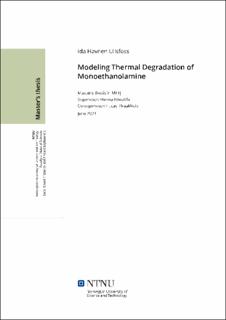| dc.contributor.advisor | Hanna Knuutila | |
| dc.contributor.author | Ida Havnen Ullsfoss | |
| dc.date.accessioned | 2021-10-21T18:24:07Z | |
| dc.date.available | 2021-10-21T18:24:07Z | |
| dc.date.issued | 2021 | |
| dc.identifier | no.ntnu:inspera:82941058:18717394 | |
| dc.identifier.uri | https://hdl.handle.net/11250/2824817 | |
| dc.description.abstract | Bakgrunn: Termisk degradering av monoetanolamin (MEA) er et ugunstig aspekt ved aminbasert karbonfangst, da det medfører tap av MEA og redusert absorpsjonskapasitet av CO2. Temperaturen i stripperen justeres for å begrense forekomsten av termisk degradering, og en bedre forståelse av nedbrytningen muliggjør en mer presis optimalisering av stripperforholdene. Målet med denne oppgaven er å øke kunnskapen om termisk nedbrytning ved å lage en modell som kan forutsi tap av MEA og dannelse av nedbrytningsprodukter, som en funksjon av forholdene i stripperen.
Metode: En allerede eksisterende modell som beskriver termisk degradering, som en funksjon av temperatur og startkonsentrasjon av CO2, ble rekonstruert. Datasettet ble utvidet for å kunne vurdere modellpresisjonen for et økt antall datapunkter, temperaturer og startkonsentrasjoner av CO2. Den totale prediksjonsfeilen i modellen økte betydelig ved utvidelse av datasettet. En optimaliseringsrutine ble derfor tillagt modellen for å forbedre tilpasningen til det fulle datasettet. Optimalisering ble utført ved hjelp av ’standard particle swarm optimization’, ved å minimere den totale rot-gjennomsnittlige kvadrerte feilen (RMSE) mellom de predikterte og de eksperimentelle verdiene. Dermed ble et nytt sett med parametere funnet for hastighetsligningene i den kinetiske modellen. RMSE ble foretrukket som objektfunksjon, da den fremmer tilpasningen av MEA, som dessuten er den mest kritiske komponenten å prediktere.
Konklusjon: Optimaliseringen reduserte den totale RMSE-verdien med 30% fra den originale modellen, forårsaket av prediksjonsforbedringene av MEA, HEEDA og HEIA. Den endelige modellen ga en presis beskrivelse av de eksperimentelle verdiene for MEA, med et gjennomsnittlig relativt avvik på 5%. De tilsvarende avvikene for nedbrytningsproduktene ble betydelig høyere, og varierte fra ca. 70 til 77 %. Dette regnes som et resultat av at tilpasningen til MEA prioriteres under optimaliseringen, forskjeller i de tilgjengelige eksperimentelle dataene, som vanskeliggjør tilpasningene, og generell usikkerhet knyttet til validiteten av den kinetiske modellen. | |
| dc.description.abstract | Background: Thermal degradation of Monoethanolamine (MEA) is an unfortunate aspect of the process of post-combustion capture (PCC) as it leads to loss of solvent and decreased solvent absorption capacity of CO2. The stripper conditions are limited to restrain the occurrence of thermal degradation, and a better understanding of the degradation would enable a more precise optimization of the stripper conditions. This thesis aimed to increase the knowledge on thermal degradation by making a model that can predict the loss of solvent and the formation of degradation products as a function of the stripper conditions.
Method: A model describing thermal degradation as a function of temperature and CO2 loading was found in literature and successfully recreated. The considered degradation products were HEIA, HEEDA, Trimer, and TriHEIA. The included data set was enlarged to evaluate the model at extended ranges of temperatures and CO2 loadings. By the addition of data, the total error of the model predictions was found to increase significantly. An optimization routine was therefore added to the model to improve the fit to the complete data set. Particle swarm optimization was used to minimize the total root mean squared error (RMSE) between the modeled and experimental values, and a new set of parameters was found for the rate equations in the kinetic model. The RMSE was preferred as the objective function to accentuate the fitting of MEA, which is the most critical to predict.
Conclusion: By optimization, the total RMSE decreased by 30% from the original model, caused by improved descriptions of the three most significant components, MEA, HEEDA, and HEIA. The final model provided adequate estimations of the experimental concentration profiles of MEA, as the associated average relative error was found to be 5%. Contrary, deficiencies in the fittings of the degradation products were reflected in average relative errors ranging from about 70 to 77%. The significant deviations are considered a result of the prioritized fitting of MEA, differences in the provided experimental data at the same experimental conditions, and general uncertainty related to the applied kinetic model. Despite the inefficiencies in describing the degradation products, the model is considered a good starting point for further model development. | |
| dc.language | eng | |
| dc.publisher | NTNU | |
| dc.title | Modeling Thermal Degradation of Monoethanolamine | |
| dc.type | Master thesis | |
